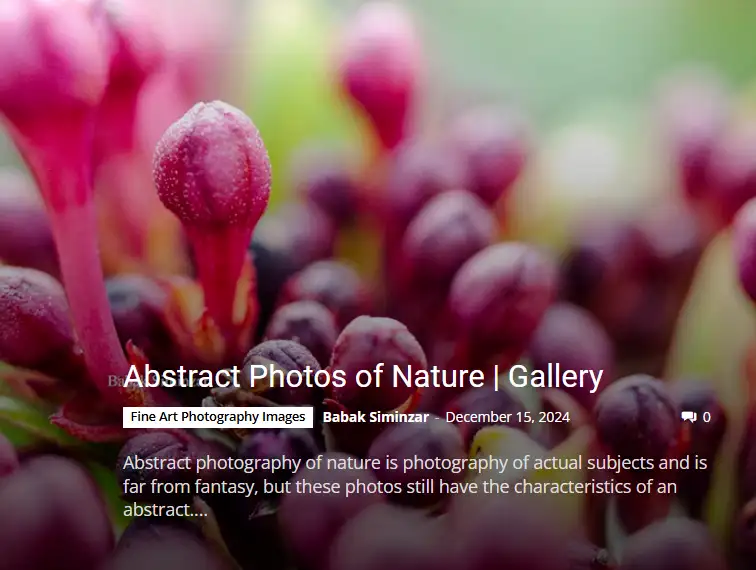Abstract photography is a stimulating genre that deviates from the confines of literal representation, allowing viewers to explore shapes, colors, textures, and patterns in novel and innovative ways. Unlike traditional photography, which frequently seeks to depict reality with clarity, abstract photography encourages ambiguity, fostering personal interpretation and emotional connection. This article delves into the nature of abstract photography, its techniques, and its influence on both artists and their audiences. Please visit Fine Art Abstract Photography to see more articles.
Topics
Concept of abstract photography
Abstract photography, often known as non-objective or experimental photography, aims to create photographs that do not directly reflect reality. Instead, it focuses on visual components like shape, color, line, and texture to elicit feelings or ideas. Abstract photography encourages viewers to interact with the image on a deeper, often subconscious level by removing identifiable subjects.
Abstract photography’s attractiveness stems from its adaptability. It can be accomplished by close-ups of everyday objects, deliberate camera movement, or digital editing. The idea is to elevate the ordinary into the extraordinary, allowing viewers to see the world through a new lens.
Techniques for Abstract Photography
Photographers use several approaches to generate abstract photos. Here are some of the most popular methods.
Macro Abstract Photography
Photographers can make pictures that look like they’re from another world by zooming in on small details like the texture of a leaf, the rust on a metal surface, or the water drops on a glass. By isolating patterns and textures, macro photos can make familiar things seem strange.
Intentional Camera Movement (ICM)
Moving the camera during a long exposure is what ICM is used for to get artistic, blurred effects. With this method, you can turn landscapes, cityscapes, or even everyday scenes into lively, flowing compositions that make you feel like things are moving.
Play with Light and Shadow in Abstract Photography
A strong way to make abstract pictures is to change the light and shadow. Reflections, silhouettes, or artificial lighting are some of the techniques that photographers can use to create striking contrasts and interesting forms that catch the eye.

Please take a look at Abstract Photos of Nature Gallery to see more images
Multiple Exposures
Layering many photos in a single frame allows photographers to create strange, dreamlike compositions. This approach enables the merging of textures, colors, and forms, producing visually complex images.
The post-processing and manipulation of digital content
An infinite number of possibilities are available for the creation of abstract photos using modern editing software. Through the use of techniques such as color manipulation, shape distortion, and picture fusion, photographers are able to create one-of-a-kind, abstract outcomes that push the boundaries of conventional photography.
Effects on the Emotions and on the Concepts
Abstract photography appeals to viewers because it encourages personal interpretation. Without a defined subject, the viewer can project their own feelings, memories, or experiences onto the image. This open-endedness generates a sense of connection and wonder, as each viewer may perceive something different in the same shot.
Abstract photography allows photographers to experiment and express their ideas without being constrained by realism. It promotes risk-taking and discovery, allowing artists to express emotions or notions that might be difficult to represent using traditional methods. Please take a look at Abstract Nature Photography for more information.
Famous Abstract Photographers
Man Ray
Man Ray, a pioneer of avant-garde photography, created abstract compositions using light and objects in his photograms (or “rayographs”), challenging conventional photography.
Aaron Siskind
It was Siskind’s work that blurred the line between photography and abstract art. He was known for taking close-up pictures of urban textures like peeling paint or weathered walls.
Hiroshi Sugimoto
Sugimoto’s minimalist, long-exposure photographs of seascapes and theaters investigate time and perception, producing abstract yet tranquil images.
Minor White
He frequently implied that photography could expose the invisible or the metaphysical by infusing his abstract pictures with spiritual and philosophical meaning.
With the use of digital technologies and experimental techniques, modern photographers are still pushing the limits of abstraction.
Advice for People Who Want to Be Abstract Photographers
Here are some pointers to help you begin your exploration of abstract photography:
Look for Patterns and Textures
Train your eyes to detect details in ordinary items, such as wood grain or water ripples. Please visit Black and White Abstract Photography to see more examples.
Experiment With Perspective
To generate a new viewpoint, change your angle, get closer, or shoot from an odd vantage point.
Play with Light
Use natural or artificial light to create stark contrasts or gentle gradation.
Embrace Mistakes
Some of the best abstract photographs result from fortunate accidents, such as out-of-focus shots or inadvertent blurring.
Edit thoughtfully
Use post-processing techniques to improve your photographs, but avoid over-editing to keep the core of your original concept.
The Importance of Abstract Photography
In a world inundated with images intended to inform or tell a story, abstract photography creates a room for visual poetry. It embraces ambiguity, humor, and individual interpretation. It invites us to pause, look closely, and consider what we see—and why we see it that way.
Abstract photography reminds us that photography is more than simply a window into the world; it is also a reflection of the intellect. It provides an artistic playground where form prevails over function, and meaning is produced rather than caught.
Finally
Abstract photography is a way to show off your creativity, inventiveness, and uniqueness. By emphasizing how visual elements work together, it pushes both the photographer and the viewer to see things in new ways. If you’re a professional photographer or just starting, trying out abstract photography is a great way to push the limits of art and perception. So get your camera and start taking pictures of the beauty of the abstract.







